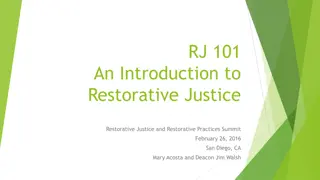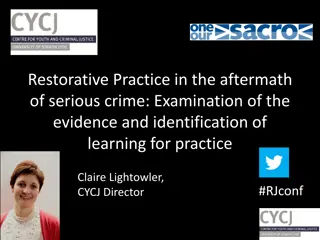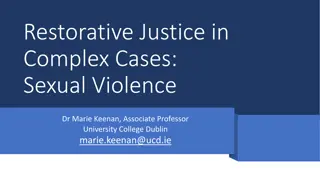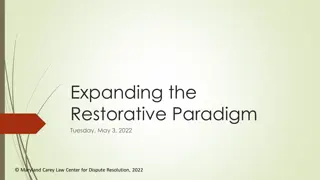Exploring Restorative Justice and Offender Rehabilitation Frameworks
Dr. Tony Ward from Victoria University of Wellington delves into the intersection of restorative justice and offender rehabilitation, proposing a hybrid normative framework for comprehensive practice guidance. He emphasizes the importance of ethical, prudential, and social norms in facilitating moral repair within the criminal justice system.
Download Presentation

Please find below an Image/Link to download the presentation.
The content on the website is provided AS IS for your information and personal use only. It may not be sold, licensed, or shared on other websites without obtaining consent from the author. Download presentation by click this link. If you encounter any issues during the download, it is possible that the publisher has removed the file from their server.
E N D
Presentation Transcript
Tony Ward, PhD, DipClinPsyc Victoria University of Wellington Tony.ward@vuw.ac.nz
*Ward, T. (2017). Restorative Justice and the Dual Role Problem Confronting Practitioners. E. Zinsstag & M Keenan (Eds.), Restorative Responses to Sexual Violence: Legal, Social and Therapeutic Dimensions. London, UK: Routledge. *Ward, T., Fox, A., & Garber M. (2014). Restorative justice, offender rehabilitation, and desistance. Restorative Justice: An International Journal, 2, 24-42. *Ward, T., Gannon, T , & Fortune, C. (2015). Restorative Justice informed moral acquaintance: Resolving the dual relationship problem in forensic and correctional psychology. Criminal Justice and Behavior, 42, 45-57. *Ward, T. & Langlands, R. (2009). Repairing the rupture: Restorative justice and offender rehabilitation. Aggression and Violent Behavior, 14, 205-214.
Desistance, correctional rehabilitation, & traditional RJ interventions on their own unable to provide adequate practice guidance Each lacks comprehensiveness and also fails to include full range of necessary norms and their practices: different lens? Solution is to view RJ-NF as a hybrid normative framework: A form of moral repair Can overcome limitations of narrow RJ, correctional, & desistance models: ethical, prudential, & social norms and associated practices seamlessly linked
Norms are specific rules partly constituted from general value principles that require people to act in certain ways: benefits & harms Ethical norms: define what are right or wrong actions and good or bad outcomes (or personal characteristics) across all practices. Prudential norms: ( natural norms ) relate to well-being concerns Social norms: relate to appropriate functioning of institutions etc.
RJ is an option for doing justice after the occurrence of an offence that is primarily oriented towards repairing the individual, relational, and social harm caused by that offence (Walgrave, 2008, p. 21). Assumes an egalitarian & relational ethical theory which meshes well with human beings natural desire to punish and to forgive Patchwork of ideas, values and practices
How do RJ theorists and practitioners approach offender rehabilitation? Evidence based models of offender rehabilitation are commonly used by practitioners working within the correctional justice system (Andrews & Bonta, 2010). Not typically utilized or referred to by restorative justice advocates when outlining a comprehensive ethical response to crime.
Two perspectives concerning the relationship between RJ and offender rehabilitation: 1. Incorporate EBP interventions into restorative justice practices or argue they are already are built in. 2. Downplay the value of rehabilitation, both as a just response to crime and as a way of reducing re- offending (McCold and Wachtel (2002).
Concerning 1: Research used to back claims based on participant satisfaction data rather than data from well-designed studies on changes in offenders array of dynamic risk factors, and/or reconviction rates. RJ practice aspects are not therapeutic in the usual sense of that term. underpinned by a theory of change, a conceptualization of crime and its causes, a set of psychological change goals, and detailed instructions for implementing a particular treatment for a specific problem are not explicitly therapeutic in the sense described above.
Concerning 2: RJ fails to account for the fundamental principles of evidence-based rehabilitation. Does not directly engage with the principles of the RNR or adapt strengths based intervention models such as the GLM in any way to work with offenders. Little attention to specific cognitive behavioral competencies required for successful rehabilitation
RJ struggles with the integration of offender rehabilitation goalsinto action plans arising from restorative encounters or experiences. Restorative justice narrowly conceived is more a social & victim-focused process. Stress on community risks and concerns. Fails to incorporate prudential norms (core values of traditional rehab)
How are desistance & RJ related? Desistance is often defined as a termination point, the last officially recorded or self-reported offense (Kazemian, 2007, p. 9). However, it is more properly seen as a dynamic, ongoing process. In essence, it is the state of stopping and staying stopped that we refer to as desistance.
Bottoms, et al. (2004) argue that desistance involves: programmed potential (i.e. assessing and targeting risk factors) contextual issues (e.g. employment, subcultural enablers or constraints and situational factors that matter in determining desistance) agency factors.
Link between RJ & desistance : moral repair tasks (reparation, apologies, accountability, acknowledgement of harm) signal to victims, community & offender readiness for reform and reconciliation. What is missing is appreciation of capacity building (skills, knowledge etc) in offenders and thus critical role of prudential norms and (therapeutic) correctional practices. THUS: desistance as traditionally conceived more concerned with social & ethical norms & related practices.
Narrow focus on DRF and recently PF Weak on post intervention practice and fails to address moral repair issues. Mistakenly views rehabilitation as primarily capability/skill acquisition rather than hybrid normative & psychological process. Technologically sophisticated but normatively na ve: ethical and social norm blindness!
Restorative Justice as a Comprehensive Normative Framework
Moral repair : restoring or creating trust and hope in a shared sense of value and responsibility (Walker, p. 28) following the experience of intentional and unjustified harm at the hands of another person or persons. Accepts that all persons involved in a specific crime (i.e., victims, members of the community, offenders) should be included in any institutional response and their interests, perspectives, and concerns respectfully acknowledged and addressed.
In RJ-CNF ethical norms function as normative constraints for rehabilitation(capacity building),RJ interventions (e.g., conferences), and social reentry and reintegration (e.g., work, social support) Moral repair: normative individualism -the interests and priorities of persons appropriate locus of ethical concern; within relational networks (see Ward, 2017). Stipulates what rehabilitation tasks should be be undertaken and why
Correctional intervention (treatment) programs should be designed to equip individuals with the social & psychological resources to seek personally meaningful goals in acceptable ways & should directly reduce offenders potential for committing further harmful actions against others (prudential & ethical tasks). Ideally, should be strength based: well-being enhancing and risk reducing
Intervention tasks reflects RJ norms concerned with moral repair Consist of combination of ethical, prudential, and social norms and associated practices: Empathy, intimacy, work. Crucial part of repairing crime # is to acquire meaningful personal identity and skills, capacities and social opportunities that facilitate translation of this into everyday social life.
Desistance processes natural or artificial (i.e., socially created) hooks for change that offer offenders chance to re enter the community and to (re) establish themselves as productive citizens. Experience of RJ guided interventions and having acquired a range of adaptive psychological and social skills through involvement in correctional programs, offenders will be better placed to capitalize on desistance moments, or hooks for change.
Humanistic and egalitarian orientation of RJ- NF ideas shape the way correctional interventions are carried out and also ensure that community interventions and supports are responsive to the interests of offenders as well as those of victims and members of the community.
RJ-CNF is a hybrid normative framework concerned with moral repair tasks. It is the glue that ensures that rehabilitation ethical, prudential, and social norms are seamlessly linked and embodied in the different phases of offender s journey: Sanction Intervention, (Re)integration























